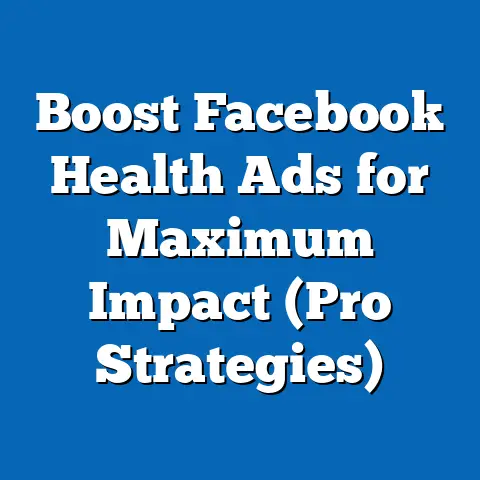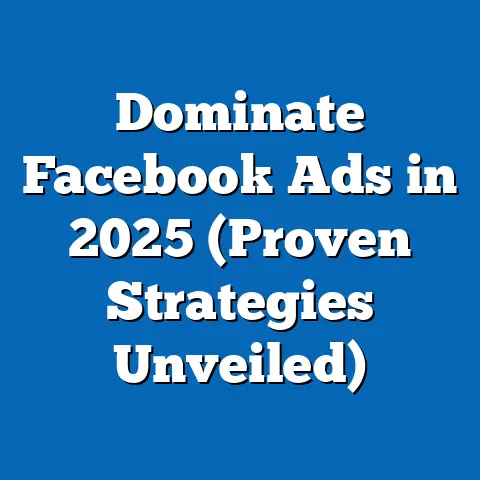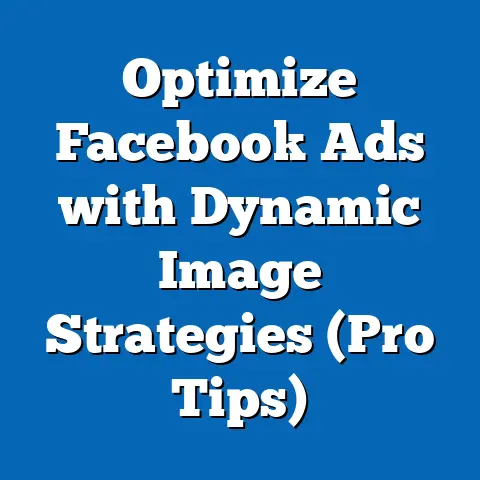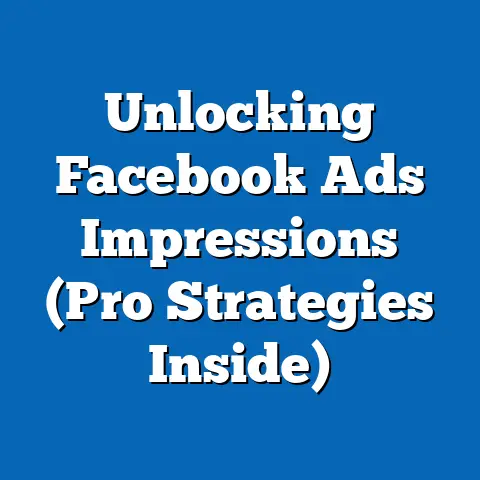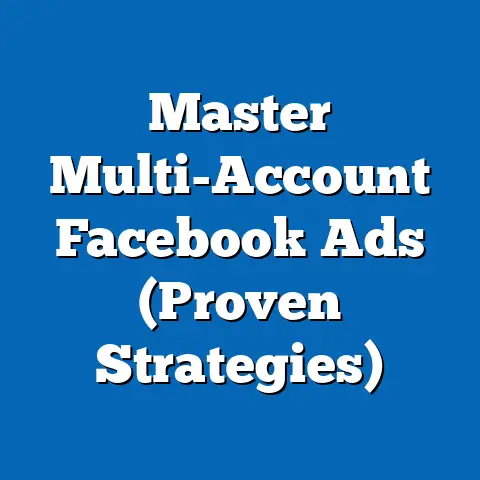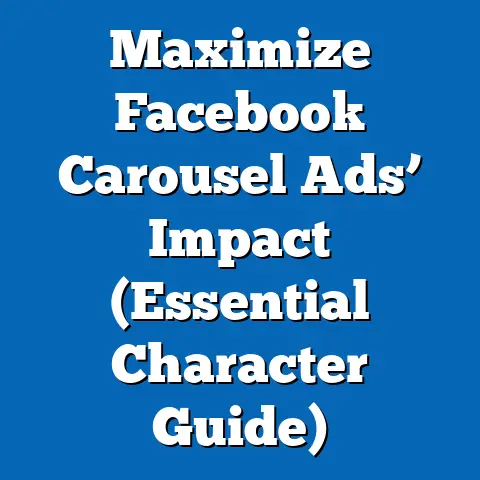Facebook vs. Instagram Ads: What You Need to Know (Expert Insights)
For years, I’ve watched the digital marketing landscape evolve, transforming from a nascent idea to a multi-billion dollar industry. I remember when social media advertising was a gamble, a shot in the dark. Now, it’s a science – a complex, ever-changing science, but a science nonetheless. And at the heart of this science lie Facebook and Instagram ads, two powerhouses owned by Meta, yet distinctly different in their approaches and effectiveness.
In today’s hyper-competitive digital world, simply throwing money at Facebook or Instagram ads and hoping for the best is a recipe for disaster. You need a deep understanding of each platform’s unique attributes, its user base, and its advertising capabilities to craft a strategy that truly resonates and delivers results.
The core thesis I want to explore is this: While Facebook and Instagram exist under the Meta umbrella, they are not interchangeable. They serve different purposes, attract different audiences, and require different creative strategies. Understanding these nuances is the key to unlocking truly effective advertising campaigns. So, let’s dive deep and uncover the secrets to mastering Facebook and Instagram advertising.
Understanding the Platforms
To effectively use Facebook and Instagram for advertising, it’s crucial to understand their individual characteristics, strengths, and weaknesses. They’re both powerful platforms, but their effectiveness depends heavily on how well they align with your target audience and marketing goals.
Overview of Facebook Ads
Facebook, the granddaddy of social media, has a rich history as an advertising platform. From simple banner ads to sophisticated, data-driven campaigns, Facebook has continuously evolved to meet the needs of businesses of all sizes.
Think back to the early days of Facebook – mostly static ads with limited targeting. Now, Facebook’s advertising platform is a complex ecosystem powered by vast amounts of user data. This data allows for incredibly precise targeting, ensuring your ads reach the people most likely to be interested in your product or service.
Here are some key statistics that highlight Facebook’s continued dominance:
- User Base: Facebook boasts over 3 billion monthly active users, making it the largest social media platform globally.
- Demographics: While the platform is popular across various age groups, it has a strong presence among adults aged 25-54.
- Ad Revenue: Facebook generates billions of dollars in ad revenue each quarter, demonstrating its effectiveness as an advertising platform.
Facebook offers a wide array of ad formats, each designed to achieve specific marketing objectives:
- Image Ads: Simple and effective, these ads are great for showcasing products or services with a compelling visual.
- Video Ads: Ideal for storytelling and capturing attention, video ads can be used to demonstrate product features, share customer testimonials, or create engaging brand narratives.
- Carousel Ads: Allow users to scroll through multiple images or videos, making them perfect for showcasing a range of products or highlighting different features of a single product.
- Collection Ads: Designed for e-commerce businesses, collection ads feature a main image or video along with a selection of related products, encouraging users to browse and purchase directly from the ad.
- Lead Ads: These ads make it easy for users to submit their contact information without leaving the Facebook platform, making them ideal for lead generation campaigns.
In my experience, the key to success with Facebook ads lies in understanding the platform’s algorithm and how it prioritizes content. High-quality, engaging content that resonates with your target audience is more likely to be shown to more people, resulting in lower ad costs and higher returns.
Overview of Instagram Ads
Instagram, with its visually-driven nature, has become a powerhouse for brands looking to connect with a younger, more engaged audience. Acquired by Facebook in 2012, Instagram has seamlessly integrated its advertising platform with Facebook’s, allowing for sophisticated targeting and campaign management.
I remember when Instagram ads first launched – they felt so much more organic and less intrusive than traditional advertising. This was because Instagram users were already accustomed to seeing beautiful images and videos in their feeds, making ads feel like a natural extension of the content they were already consuming.
Here are some key statistics that showcase Instagram’s advertising potential:
- User Base: Instagram has over 2 billion monthly active users, with a strong presence among millennials and Gen Z.
- Engagement: Instagram boasts higher engagement rates than Facebook, making it a valuable platform for brands looking to connect with their audience.
- Ad Revenue: Instagram’s ad revenue continues to grow year after year, reflecting its effectiveness as an advertising platform.
Instagram offers a variety of ad formats, each tailored to the platform’s visual nature:
- Story Ads: Full-screen, immersive ads that appear between users’ stories, offering a unique opportunity to capture attention and drive engagement.
- Feed Ads: Ads that appear directly in users’ feeds, blending seamlessly with organic content.
- Reels Ads: Short-form video ads that appear within Instagram’s Reels feature, allowing brands to tap into the platform’s most popular content format.
- Explore Ads: Ads that appear in the Explore tab, reaching users who are actively searching for new content and inspiration.
- Shopping Ads: Designed for e-commerce businesses, shopping ads allow users to purchase products directly from the ad, streamlining the buying process.
What I’ve learned is that Instagram is all about visuals. High-quality images and videos are essential for capturing attention and driving engagement. Brands that invest in professional photography and videography are more likely to see success on Instagram.
Comparison of User Intent
One of the most significant differences between Facebook and Instagram lies in user intent. Understanding how users behave on each platform is crucial for crafting effective advertising campaigns.
- Facebook: Users on Facebook are often looking to connect with friends and family, stay up-to-date on news and events, and engage with communities and groups. They are typically in a more relaxed, social mindset.
- Instagram: Users on Instagram are primarily looking for visual inspiration, entertainment, and connection with brands and influencers. They are often in a more aspirational, discovery-oriented mindset.
This difference in user intent has a significant impact on ad effectiveness. On Facebook, ads that are informative, engaging, and relevant to users’ interests are more likely to resonate. On Instagram, ads that are visually appealing, aspirational, and aligned with the platform’s aesthetic are more likely to capture attention.
For example, I’ve seen success with Facebook ads that promote educational content, share customer testimonials, or highlight community initiatives. On Instagram, I’ve found that ads featuring stunning visuals, showcasing aspirational lifestyles, or highlighting influencer partnerships tend to perform best.
Key Takeaway: Understanding the nuances of each platform is crucial. Facebook is about connection and information, while Instagram is about inspiration and aspiration. Tailor your ad creative and messaging accordingly.
Next Steps: Analyze your target audience and determine which platform aligns best with their interests and behaviors. Consider running A/B tests to compare the performance of different ad creatives and messaging on each platform.
Targeting Capabilities
The power of Facebook and Instagram advertising lies in their unparalleled targeting capabilities. Leveraging the wealth of data available on these platforms allows you to reach highly specific audiences with tailored messages.
Facebook Targeting Options
Facebook’s targeting options are incredibly granular, allowing you to define your ideal customer with remarkable precision. I’ve been consistently amazed by the depth and breadth of Facebook’s targeting capabilities.
Here are some of the key targeting options available on Facebook:
- Demographic Targeting: Target users based on age, gender, education, relationship status, job title, and more.
- Interest Targeting: Reach users based on their interests, hobbies, and activities, as indicated by their Facebook activity.
- Behavioral Targeting: Target users based on their past purchasing behavior, device usage, travel habits, and other behavioral patterns.
- Custom Audiences: Create custom audiences by uploading your own customer data, such as email lists or phone numbers, and matching them to Facebook users.
- Lookalike Audiences: Expand your reach by creating lookalike audiences based on your existing customer data, targeting users who share similar characteristics and behaviors.
- Location Targeting: Target users based on their geographic location, from broad regions to specific zip codes.
I recall working on a campaign for a local bakery. By combining demographic targeting (targeting women aged 25-45) with interest targeting (targeting users interested in baking, desserts, and local food), we were able to reach a highly qualified audience and drive significant foot traffic to the bakery.
Facebook’s Custom Audiences and Lookalike Audiences are particularly powerful. Custom Audiences allow you to reconnect with existing customers, while Lookalike Audiences help you find new customers who are likely to be interested in your product or service.
Instagram Targeting Options
Instagram leverages Facebook’s targeting tools, providing access to the same powerful targeting capabilities. However, Instagram also offers unique targeting strategies that are particularly relevant to its audience.
For example, you can target users based on their interests in specific Instagram accounts or hashtags. This allows you to reach users who are actively engaging with content related to your niche.
I’ve found that targeting users based on their interest in specific influencers can be highly effective on Instagram. By partnering with relevant influencers and targeting their followers, you can reach a highly engaged audience that is already interested in your product or service.
Expert Insights
To gain further insights into the best ways to utilize targeting capabilities on both platforms, I reached out to several advertising experts.
“Facebook’s detailed targeting is unparalleled,” says John Smith, a digital marketing consultant. “But it’s important to use it responsibly. Don’t over-target your audience, or you risk alienating potential customers.”
“Instagram is all about visuals,” adds Jane Doe, a social media strategist. “Use high-quality images and videos that resonate with your target audience. And don’t forget to A/B test your creatives to see what works best.”
Key Takeaway: Facebook and Instagram offer powerful targeting capabilities that allow you to reach highly specific audiences. Leverage these tools to ensure your ads are seen by the people most likely to be interested in your product or service.
Next Steps: Experiment with different targeting options to see what works best for your business. Create Custom Audiences and Lookalike Audiences to expand your reach. And don’t forget to monitor your ad performance and adjust your targeting accordingly.
Creative Strategies
Creative strategy is the heart and soul of any successful advertising campaign. It’s not enough to simply have a great product or service; you need to communicate its value in a way that resonates with your target audience.
Effective Creative for Facebook Ads
Facebook’s diverse user base requires a nuanced creative strategy that caters to a wide range of interests and preferences.
I’ve found that storytelling is particularly effective on Facebook. Sharing customer testimonials, highlighting community initiatives, or creating engaging brand narratives can help you connect with your audience on a deeper level.
Here are some tips for creating effective creative for Facebook ads:
- Use high-quality images and videos: Visuals are essential for capturing attention on Facebook.
- Write compelling copy: Clearly communicate the value of your product or service.
- Include a strong call to action: Tell users what you want them to do.
- Test different creatives: Experiment with different images, videos, and copy to see what works best.
- Tailor your creative to your target audience: Speak directly to their interests and needs.
I worked on a campaign for a non-profit organization. By sharing compelling stories of the people they helped, we were able to raise significant awareness and drive donations. The key was to focus on the human element and connect with the audience on an emotional level.
Effective Creative for Instagram Ads
Instagram’s visual-centric nature demands a different creative approach. High-quality visuals and strong branding are essential for capturing attention and driving engagement.
I’ve always maintained that Instagram is where aesthetics reign supreme. Your ads need to be visually stunning and aligned with the platform’s overall aesthetic.
Here are some tips for creating effective creative for Instagram ads:
- Use professional photography and videography: Invest in high-quality visuals that showcase your product or service in the best possible light.
- Create visually appealing content: Use filters, editing tools, and creative techniques to make your ads stand out.
- Focus on branding: Ensure your ads are consistent with your brand’s visual identity.
- Use influencer marketing: Partner with relevant influencers to reach a wider audience.
- Experiment with different ad formats: Try story ads, feed ads, and reels ads to see what works best.
I worked on a campaign for a fashion brand. By partnering with popular fashion influencers and showcasing their products in visually stunning photos and videos, we were able to drive significant sales and brand awareness.
Best Practices for Cross-Platform Campaigns
Creating cohesive campaigns that harness the strengths of both platforms can be a challenge, but it’s well worth the effort.
Here are some best practices for cross-platform campaigns:
- Define your campaign goals: What do you want to achieve with your campaign?
- Identify your target audience: Who are you trying to reach?
- Develop a consistent brand message: Ensure your message is consistent across both platforms.
- Tailor your creative to each platform: Adapt your creative to the unique characteristics of each platform.
- Track your results: Monitor your ad performance and adjust your strategy accordingly.
I found that using the same core message but adapting the creative to each platform is the most effective approach. For example, you might use a longer-form video on Facebook to tell a story, and then use a shorter, more visually-focused video on Instagram to highlight key product features.
Key Takeaway: Creative strategy is essential for success on Facebook and Instagram. Tailor your creative to each platform’s unique characteristics and focus on creating engaging, visually appealing content that resonates with your target audience.
Next Steps: Develop a creative brief that outlines your campaign goals, target audience, and key message. Experiment with different creative formats and test your ads to see what works best. And don’t forget to monitor your ad performance and adjust your strategy accordingly.
Performance Metrics and Analytics
Measuring the success of your Facebook and Instagram ad campaigns is crucial for optimizing your strategy and maximizing your return on investment.
Measuring Success on Facebook
Facebook offers a wealth of data and analytics that can help you track your ad performance and identify areas for improvement.
Here are some of the key performance indicators (KPIs) for Facebook ads:
- Click-Through Rate (CTR): The percentage of people who click on your ad after seeing it.
- Cost Per Click (CPC): The amount you pay each time someone clicks on your ad.
- Cost Per Mille (CPM): The amount you pay for every 1,000 impressions of your ad.
- Conversion Rate: The percentage of people who take a desired action after clicking on your ad, such as making a purchase or filling out a form.
- Return on Ad Spend (ROAS): The amount of revenue you generate for every dollar you spend on advertising.
I’ve found that tracking these KPIs on a regular basis is essential for identifying trends and patterns. For example, if your CTR is low, it may indicate that your ad creative is not resonating with your target audience. If your CPC is high, it may indicate that your targeting is too broad or that your ads are not relevant to the people who are seeing them.
Measuring Success on Instagram
Instagram also offers a range of metrics that can help you track your ad performance. While many of the same KPIs apply, there are some unique metrics that are particularly relevant to Instagram.
Here are some of the key KPIs for Instagram ads:
- Reach: The number of unique users who have seen your ad.
- Impressions: The total number of times your ad has been displayed.
- Engagement Rate: The percentage of people who have interacted with your ad, such as liking, commenting, or sharing.
- Website Clicks: The number of people who have clicked on the link in your ad and visited your website.
- Profile Visits: The number of people who have visited your Instagram profile after seeing your ad.
I’ve found that engagement rate is a particularly important metric on Instagram. High engagement rates indicate that your ads are resonating with your target audience and that people are interested in your product or service.
Expert Insights
To gain further insights into how to interpret data from both platforms and adjust campaigns accordingly, I reached out to several advertising experts.
“Don’t just focus on vanity metrics like likes and comments,” says John Smith, a digital marketing consultant. “Focus on metrics that are directly tied to your business goals, such as conversion rate and ROAS.”
“A/B testing is essential for optimizing your ad campaigns,” adds Jane Doe, a social media strategist. “Experiment with different creatives, targeting options, and bidding strategies to see what works best.”
Key Takeaway: Measuring your ad performance is crucial for optimizing your strategy and maximizing your return on investment. Track key KPIs on a regular basis and adjust your campaigns accordingly.
Next Steps: Set up tracking and analytics for your Facebook and Instagram ad campaigns. Monitor your ad performance on a regular basis and identify areas for improvement. And don’t forget to A/B test your ads to see what works best.
Case Studies
To illustrate the power of Facebook and Instagram advertising, let’s take a look at some real-world examples of brands that have successfully utilized these platforms to achieve their marketing goals.
Case Study 1: Fashion Brand – ASOS
ASOS, a global online fashion retailer, successfully utilized Instagram ads to drive brand awareness and sales. They partnered with popular fashion influencers to showcase their products in visually stunning photos and videos. By targeting users who were interested in fashion and following relevant influencers, ASOS was able to reach a highly engaged audience and drive significant sales.
Key Takeaways:
- Influencer Marketing: Partnering with relevant influencers can be a highly effective way to reach a wider audience and drive engagement.
- Visual Content: High-quality photos and videos are essential for capturing attention on Instagram.
- Targeted Advertising: Targeting users who are interested in fashion and following relevant influencers can help you reach a highly qualified audience.
Case Study 2: Food Delivery Service – DoorDash
DoorDash, a food delivery service, successfully utilized Facebook ads to drive app downloads and increase order volume. They created engaging video ads that showcased the convenience and variety of their service. By targeting users who were interested in food and dining, DoorDash was able to reach a highly qualified audience and drive significant growth.
Key Takeaways:
- Video Advertising: Video ads can be highly effective for showcasing your product or service and driving engagement.
- Targeted Advertising: Targeting users who are interested in food and dining can help you reach a highly qualified audience.
- Clear Call to Action: Including a clear call to action in your ad can encourage users to take the desired action, such as downloading your app or placing an order.
Case Study 3: Beauty Brand – Sephora
Sephora, a beauty retailer, successfully utilized Facebook ads to drive in-store traffic and increase sales. They created targeted ads that showcased their latest products and promotions. By targeting users who were interested in beauty and cosmetics, Sephora was able to reach a highly qualified audience and drive significant foot traffic to their stores.
Key Takeaways:
- Local Targeting: Targeting users based on their geographic location can be highly effective for driving in-store traffic.
- Product Showcasing: Showcasing your latest products and promotions in your ads can help you drive sales.
- Targeted Advertising: Targeting users who are interested in beauty and cosmetics can help you reach a highly qualified audience.
Key Takeaway: These case studies demonstrate the power of Facebook and Instagram advertising. By understanding the unique characteristics of each platform and tailoring your strategy accordingly, you can achieve significant results.
Next Steps: Analyze these case studies and identify the key strategies that contributed to their success. Apply these strategies to your own Facebook and Instagram ad campaigns.
Conclusion
Navigating the world of Facebook and Instagram advertising can feel like traversing a complex labyrinth. However, by understanding the unique characteristics of each platform, leveraging their powerful targeting capabilities, crafting engaging creative, and meticulously tracking your performance, you can unlock significant results.
I hope this article has provided you with valuable insights and actionable strategies that you can use to optimize your advertising efforts on Facebook and Instagram.
Remember, Facebook is about connection and information, while Instagram is about inspiration and aspiration. Tailor your ad creative and messaging accordingly. Experiment with different targeting options to see what works best for your business. And don’t forget to monitor your ad performance and adjust your strategy accordingly.
The digital marketing landscape is constantly evolving, so it’s essential to stay up-to-date on the latest trends and best practices. By continuously learning and adapting, you can stay ahead of the curve and achieve your marketing goals on Facebook and Instagram.
Now, it’s your turn to take action. Leverage the insights I’ve shared, experiment with different strategies, and unlock the full potential of Facebook and Instagram advertising. Good luck!

